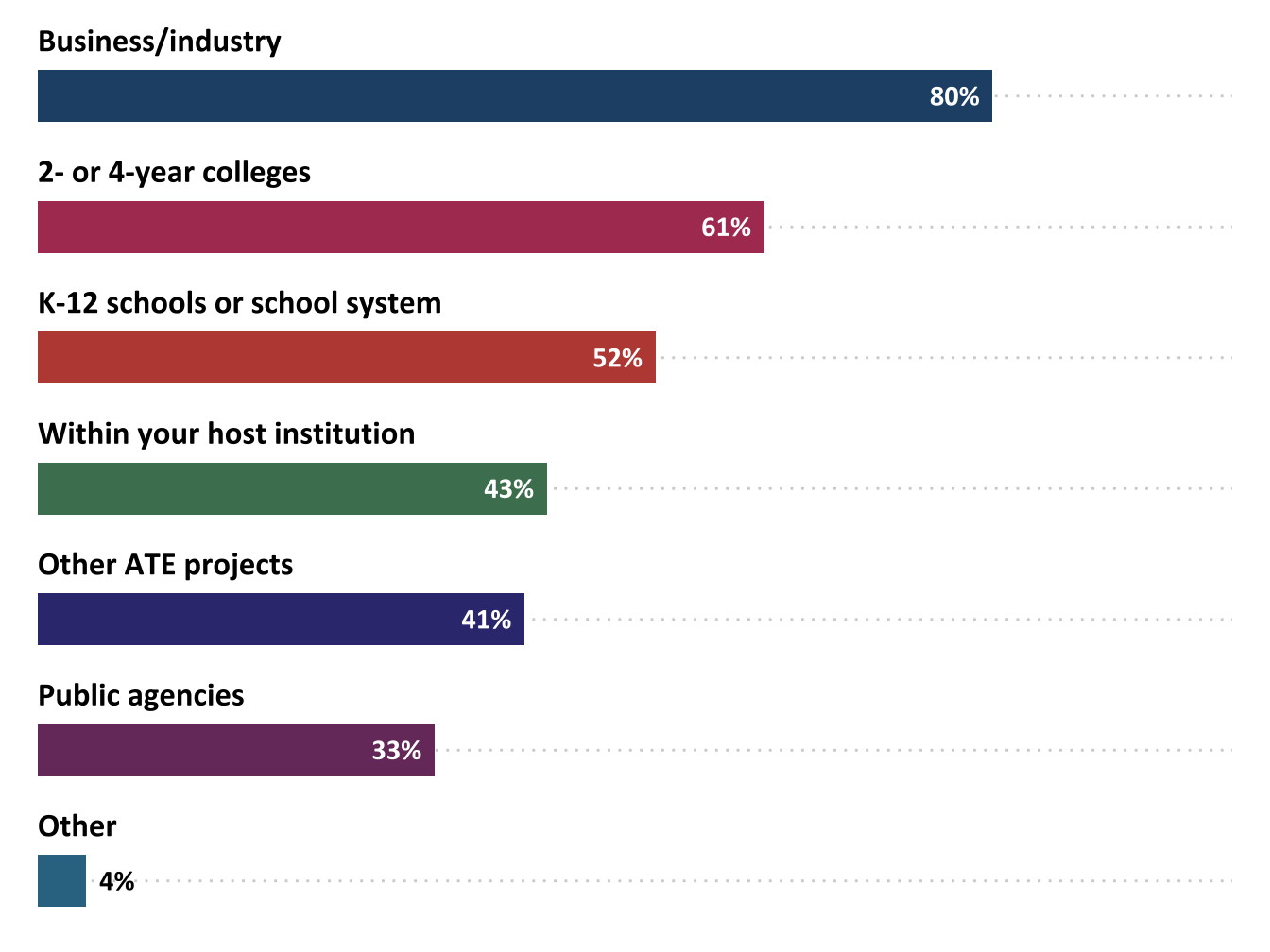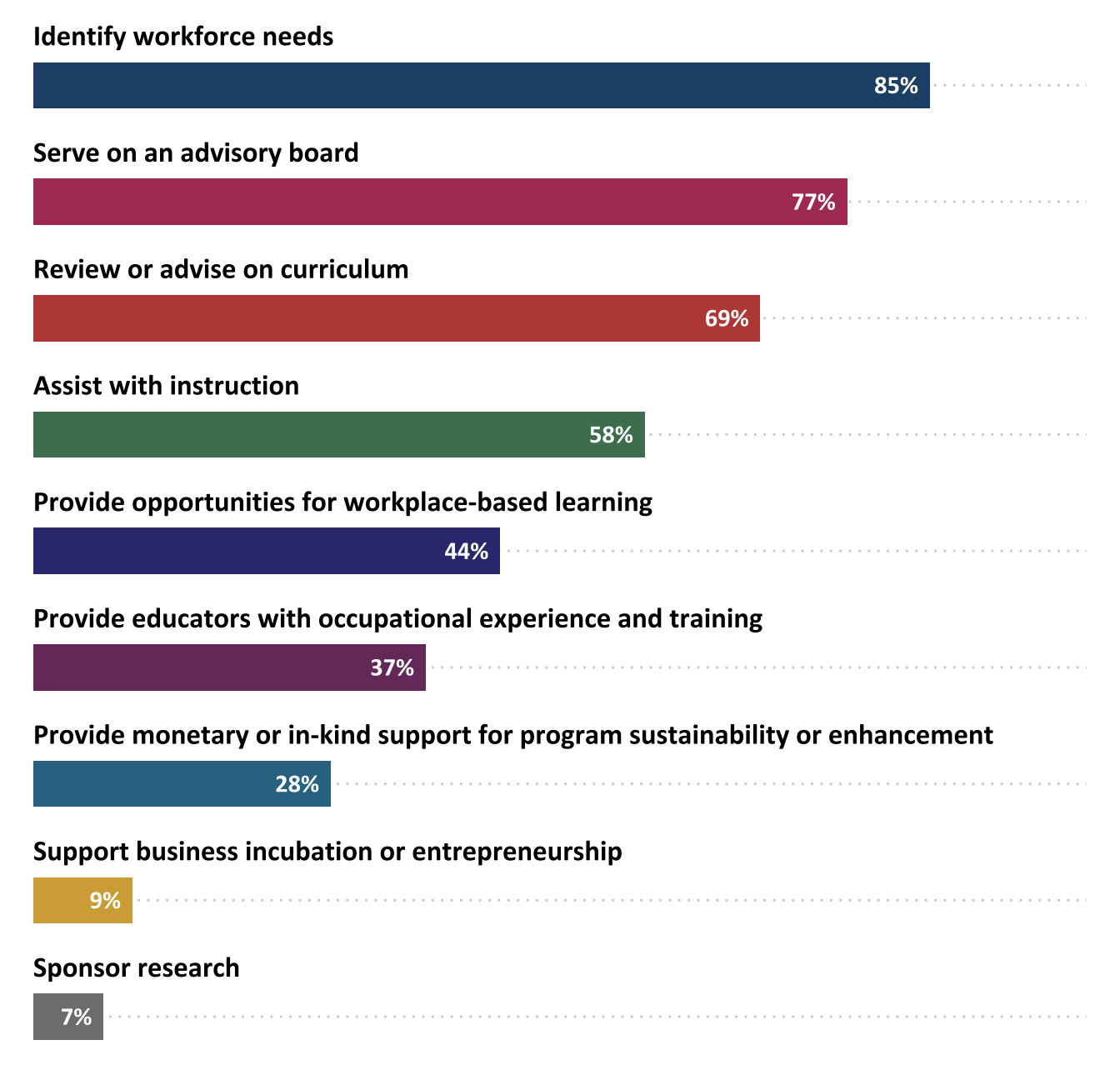
Chapter 10 Collaboration
10.0.0.0.1 NSF encourages ATE projects to partner with other institutions of higher education, secondary schools, businesses, industries, economic development agencies, and/or government agencies. The ATE program solicitation emphasizes the importance of engaging with industry to ensure programs are responsive to workforce needs and leveraging the assets of industry in preparing students for employment (National Science Foundation (NSF), 2021). According to the Brookings Institution, hallmarks of successful community college based workforce training programs include employer involvement in curriculum development and workplace experiences for students (Soliz, 2016).
10.0.0.0.2 ATE PIs were asked about the types of entities with which they collaborated and the benefits of those collaborations, including monetary and in-kind support. Projects that collaborated with business and industry were asked to identify the specific ways in which they worked with these groups.
10.1 Collaboration
10.1.0.1 ATE projects collaborated with 7,410 other organizations and institutions.
In 2021, ATE projects collaborated with 2,740 business and industry partners, 1,230 K–12 schools, 1,850 colleges, 610 other ATE projects, 590 entities within their host institutions, 340 public agencies, and 60 other types of partners. ATE projects collaborated with a median of Five business and industry groups, Two K–12 schools, Two colleges, and One other ATE project.
10.1.0.1.1 ATE projects most frequently collaborated with business and industry groups, followed by other two- or four-year colleges.

Figure 10.1: Percentage of ATE projects that collaborated with other groups, by type (n=319)
Most projects that indicated they worked with other types of partners identified these collaborators as community organizations and professional associations.
Collaborators provided over $10 million in monetary and in-kind support to 124 ATE projects.

Thirteen percent of projects reported receiving monetary support from collaborators, while 29% reported receiving in-kind support. The median contributions for monetary support and in- kind support across projects were $21,130 and $10,000, respectively. Two projects reported 59% of the total in-kind support received by ATE projects in 2021. Of the 104 projects that reported in-kind support, this primarily consisted of staff time (67%) and equipment (42%). Other types of in-kind support included access to facilities, materials, and supplies.
Participating with business and industry is important to the ATE community. The next page presents more information on how projects collaborated with these groups.
10.2 Collaboration with Business and Industry
10.2.0.1 Eighty percent of ATE projects collaborated with business and industry partners.
A total of 255 projects reported collaborating with business and industry groups. Most used these partners to identify workforce needs, serve on an advisory board, or review and advise on curriculum.

Figure 10.2: Percentage of projects reporting contributions from business and industry partners (n=255)
Business and industry representatives serve on advisory boards for 197 projects. Most of these projects (56%) reported that their advisors from business and industry committed two to five hours per year to their ATE projects.
When asked to identify benefits of collaborating with different organizations and groups, PIs frequently pointed to the utility of the information that they received from them. For example, one PI noted, they provide
“Continuous improvement from learning from others, benchmarking techniques and approaches, and accomplishing center objectives of helping to create infrastructure for the nation.”
Collaborations with industry groups were also noted by PIs as important to project innovation and growth, allowing PIs’ work to “reach a larger audience” and “understand industry needs.”
As a result of collaborating with industry partners, one respondent noted that their project was
“Determining industry needs as it relates to curriculum development and sustainability. Also, the recruitment of students into the program. Lastly, to increase the job opportunities for current and future students.”